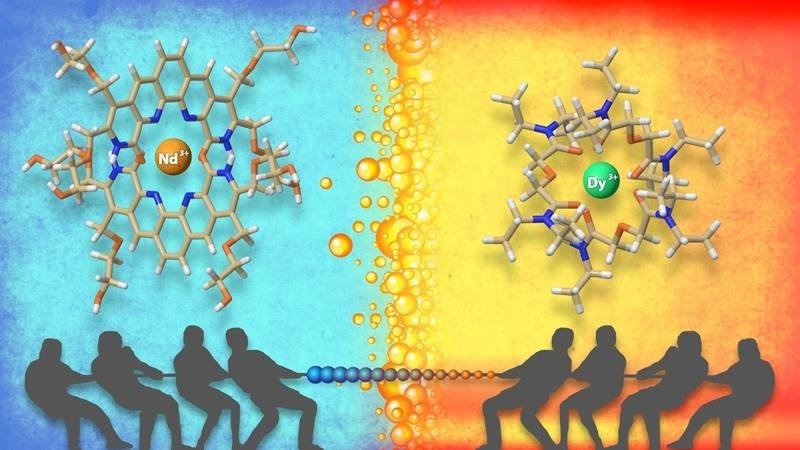Reviewed by Lexie CornerApr 4 2024
Lanthanides are metals with beneficial properties for renewable energy technologies like electric vehicles and wind turbines, as well as a variety of other applications. These components include several important materials. In nature, lanthanides are frequently found combined. Industry must separate them to capitalize on their unique features.
 Water-soluble and oil-soluble organic molecules effectively separate different elements in the lanthanide series of the Periodic Table. Image Credit: Adam Malin (with contributions from Santa Jansone-Popova and Alexander Ivanov), Oak Ridge National Laboratory
Water-soluble and oil-soluble organic molecules effectively separate different elements in the lanthanide series of the Periodic Table. Image Credit: Adam Malin (with contributions from Santa Jansone-Popova and Alexander Ivanov), Oak Ridge National Laboratory
However, traditional methods of separating these materials are time-consuming, expensive, and wasteful. Scientists have created an effective new approach for selecting specific lanthanides. The method mixes two different substances. One likes water and catches lighter lanthanides, whereas the other prefers oil and captures heavier lanthanides.
The Impact
Combining a water-loving and oil-loving compound to extract specific components from a chemical mixture is possible on an industrial scale. When the process is scaled up, less equipment, chemicals, and waste is generated. As a result, this new technique would be more ecologically friendly and efficient than current ones.
Summary
Separating specific rare earth elements from one another is the most difficult and costly part of producing pure rare earth materials for clean energy technologies, including the 14 lanthanides, yttrium, and scandium.
Researchers at Oak Ridge National Laboratory mixed two distinct types of organic substances, one of which prefers water and the other oil. These substances prefer certain rare earth elements. For example, one exhibits significant interactions with lesser rare earth elements, while the other is more interested in heavier ones.
The scientists tested the approach with water and oil, two distinct liquids that do not combine. They dissolved the substance that loved water in water and put the substance that loved oil in oil. They discovered that the one-substance strategy used earlier was less effective than the two-substance approach in helping to differentiate the lightest and heaviest rare earth elements.
They employed various techniques to investigate how organic substances and rare earth elements interact. The result was useful information on how the process works, as well as suggestions for how to enhance the separation system further.
The Department of Energy Office of Science, Office of Basic Energy Sciences, Separation Science Program, and Materials Chemistry Program all funded this study.
Journal Reference:
Johnson, K. R., et al. (2024) Size Selective Ligand Tug of War Strategy to Separate Rare Earth Elements. JACS Au. doi:10.1021/jacsau.2c00671